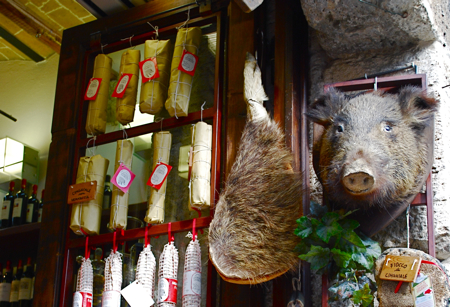As American chefs and diners are coming to understand, the idea of “Italian food” is something of a false construction. Italian cuisine is inherently regional; little connects the creamy risotti of Lombardy with, say, the spicy pastas of Calabria. But even within regions, the dishes on the table vary widely—provinces, cities, and even small towns pride themselves on local specialties that, they swear, are properly made nowhere else.

In the tiny medieval town of San Gimignano, tucked the hills outside of Siena, that specialty is the cinghiale, or wild boar. The meat figures heavily in the Tuscan diet, and turns up on any number of restaurant menus in Siena or Florence. But in San Gimignano, the boar is far more than a sauce for pappardelle. Local organizations still hold boar-hunting championships, not only as internal competitions but as a spectator sport. And stuffed boar heads look out from every local deli—pandering to curious tourists, surely, but also reflecting the incredible variety of boar products inside.
On Via San Giovanni, for instance,
La Buca di Montauto stocks an entire display with house-prepared boar:
salami di cinghiale flavored with pine nuts, or fennel, or myrtle, or truffle;
prosciutto di cinghiale, far drier and saltier than comparable cured hams; and deep red wild boar fillet, ready for the stovetop.
Much leaner than other species of pig, boar meat has a particularly tight grain with little fat; and dark and gamey, it holds up well to other strong flavors. Many restaurants simply stew the meat with tomato and olive oil, adding necessary moisture and fat; this may be served on its own, or over thick stands of pici, a hand-rolled Tuscan pasta. And others stew cinghiale with ginepro, sharp juniper berries softened and sweetened in a base of red wine.
The wild boar, of course, is hardly the sole product of San Gimignano; the meat is enjoyed from the United States to Korea and beyond. But local specialities are matters of perception. San Gimignano has always prided itself on its cinghiale—and with that tradition intact, the wild boar remains essential to the cuisine of this tiny town.